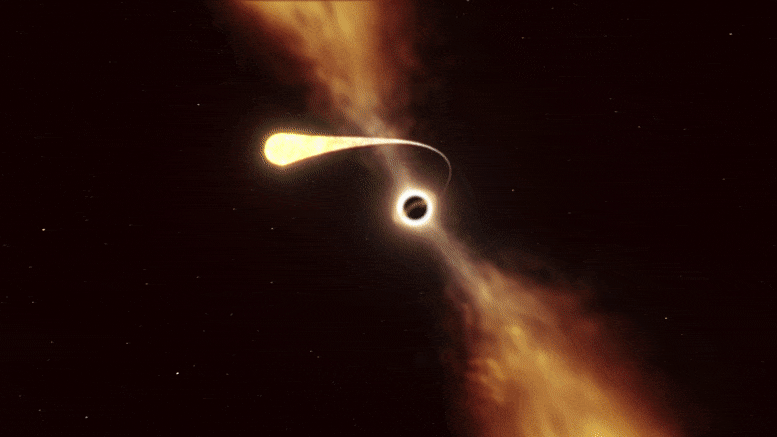
This animation depicts a star experiencing spaghettification as it’s sucked in by a supermassive black hole during a ‘tidal disruption event’. Credit: ESO/M. Kornmesser
Watch as eight stars skirt a black hole 1 million times the mass of the Sun in these supercomputer simulations. As they approach, all are stretched and deformed by the black hole’s gravity. Some are completely pulled apart into a long stream of gas, a cataclysmic phenomenon called a tidal disruption event. Others are only partially disrupted, retaining some of their mass and returning to their normal shapes after their horrific encounters.
Watch eight model stars stretch and deform as they approach a virtual black hole 1 million times the mass of the Sun. The black hole rips some stars apart into a stream of gas, a phenomenon called a tidal disruption event. Others manage to withstand their close encounters. These simulations show that destruction and survival depend on the stars’ initial densities. Yellow represents the greatest densities, blue the least dense. Credit: NASA’s Goddard Space Flight Center/Taeho Ryu (MPA)
These simulations, led by Taeho Ryu, a fellow at the Max Planck Institute for Astrophysics in Garching, Germany, are the first to combine the physical effects of Einstein’s general theory of relativity with realistic stellar density models. The virtual stars range from about one-tenth to 10 times the Sun’s mass.
The division between stars that fully disrupt and those that endure isn’t simply related to mass. Instead, survival depends more on the star’s density.

From left to right, this illustration shows four snapshots of a virtual Sun-like star as it approaches a black hole with 1 million times the Sun’s mass. The star stretches, looses some mass, and then begins to regain its shape as it moves away from the black hole. Credit: NASA’s Goddard Space Flight Center/Taeho Ryu (MPA)
Ryu and his team also investigated how other characteristics, such as different black hole masses and stellar close approaches, affect tidal disruption events. The results will help astronomers estimate how often full tidal disruptions occur in the universe and will aid them in building more accurate pictures of these calamitous cosmic occurrences.
Reference: “Tidal Disruptions of Main-sequence Stars. I. Observable Quantities and Their Dependence on Stellar and Black Hole Mass” by Taeho Ryu, Julian Krolik, Tsvi Piran and Scott C. Noble, 25 November 2021, The Astrophysical Journal.
DOI: 10.3847/1538-4357/abb3cf
https://ift.tt/3lhj90J
Science
No comments:
Post a Comment